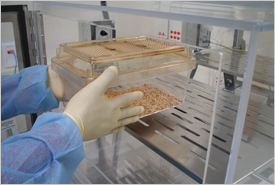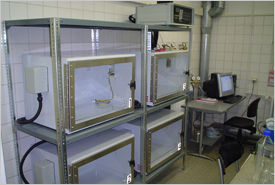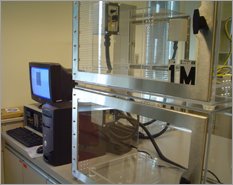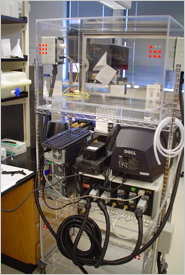
SOMETIMES CELLS NEED TO STILL BE IN THE BODY
... to complement in vitro data with in vivo data.
CELL RESEARCH: Whole organism modeling is sometimes necessary in order to complement and substantiate cell culture data. Some cellular phenomena can only be modeled by exposure of whole organisms during different stages of development to various physiologic gases. Not surprising, these are the same gases important for cells in the dish. In contrast to cells in vitro, cellsin vivo still have local communication ties to neighboring cells. They also still have humoral and neural communication lines to distant cells and organs intact. These communications are some of the most difficult simulations to create in vitro, even for Cytocentric cell incubation and processing.
... to discover and develop new medicines and therapies.
DISEASE RESEARCH: Animal models of the disease are often necessary to discover the underlying molecular, genetic, and cellular mechanisms causing the disease, and to develop new therapeutic approaches.
DRUG DEVELOPMENT: Animal models are absolutely necessary for pre-clinical testing of new pharmaceuticals in order to assure safety and efficacy before testing in humans.
THERAPEUTIC MODELING: Animal models are necessary for refining traditional respiratory therapies and developing new respiratory therapies.
ANIMAL MODELING EQUIPMENT
Equipment consists of various chambers designed to hold animal cages and various compatible controllers that generate appropriate physiologic or pathologic exposures inside the chambers to create the models.
|
Chronic exposures to hypoxia, hyperoxia, and hypercapnia can be simulated with ProOx/ProCO2controllers |
Simultaneously simulate multiple dynamic O2/CO2/CO/NO exposures with our OxyCycler series of controllers |
DISEASE MODELS
- Ocular Angiogenesis – Abnormal blood vessel formation in the eye is a major cause of blindness. Conditioning newborn animals with various hyperoxic, hypercapnic exposures, creates rich retinal neovascularization when animals are returned to normal air, and that simulates to various degrees the abnormal blood vessel formation seen in Retinopathy of Prematurity, Diabetic Retinopathy, and Adult Macular Degeneration. These models are used widely to study angiogenesis.
- Pulmonary Hypertension – Chronic hypoxia
- Systemic Hypertension – Chronic intermittent hypoxia
- Apnea– Acute hypoxia and/or hypercapnia
- Sleep Apnea – Chronic periodic intermittent hypoxia and/or hypercapnia
- Apnea of Prematurity – Chronic sporadic hypoxia and/or hypercapnia
- SIDS (Sudden Infant Death Syndrome) – Progressive acute hypercapnia and hypoxia
- Atherosclerosis – Chronic moderate intermittent hypoxia
- Ischemia (Cardiac Infarction, Stroke, etc.) – Acute hypoxia usually in conjunction with surgical clamping of major artery.
- COPD (Chronic Obstructive Pulmonary Disease) – Chronic ozone exposure followed by moderate progressive chronic hypoxia and/or hypercapnia.
- Pulmonary Fibrosis – Chronic or intermittent ozone exposure.
- ADHD (Attention Deficit Hyperactivity Disorder) – Maternal gestational intermittent hypoxia.
- Polycythemia – Chronic hypoxia
- Developmental Disabilities / Eclampsia – Newborn chronic deep hypoxia in conjunction with surgical ablation procedure
- Recreational Hyperoxia (Oxygen Bars, athletic oxygen supplementation) – Acute hyperoxia
- Recreational Hypoxia (Athletic conditioning) – Chronic periodic moderate hypoxia
- Occupational Hypoxia / Altitude Sickness (airline, observatory astronomers, mining) – Chronic or periodic moderate hypoxia
- Acute Mountain Sickness – Progressive graded hypoxia
THERAPEUTIC MODELS
- Traditional Respiratory Therapy – There's a growing recognition that traditional oxygen supplementation is a two edge sword; along with the immediate benefit there is a long term price to pay. High oxygen causes oxidative damage to cells lining the respiratory tract.
- New Carbon Monoxide Therapy – Carbon monoxia and or hyperoxia or hypoxia and or hypercapnia
- New Nitric Oxide Therapy
- New Hypoxia Therapy
|
Sleep apnea modeling: |
|
Ischemia-reperfusion modeling: |
|
Retinopathy of prematurity modeling: |
|
Pulmonary hypertension modeling: |
|
Hypercapnia model for lung injury: |
|
Ocular angiogenesis modeling: |
 Forgalmazott termékeink gyártói - keressen gyártó szerint a logóra kattintva
Forgalmazott termékeink gyártói - keressen gyártó szerint a logóra kattintva












